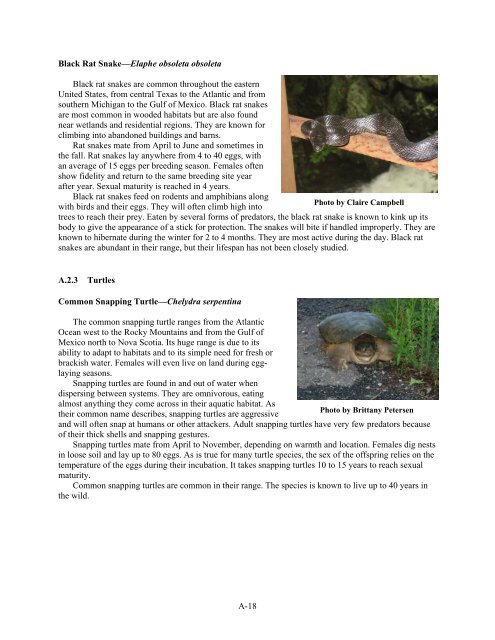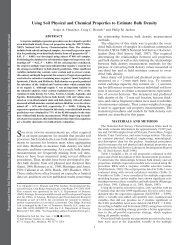Reptile and Amphibian Abundance and Distribution Survey - Oak ...
Reptile and Amphibian Abundance and Distribution Survey - Oak ...
Reptile and Amphibian Abundance and Distribution Survey - Oak ...
- No tags were found...
You also want an ePaper? Increase the reach of your titles
YUMPU automatically turns print PDFs into web optimized ePapers that Google loves.
Black Rat Snake—Elaphe obsoleta obsoletaBlack rat snakes are common throughout the easternUnited States, from central Texas to the Atlantic <strong>and</strong> fromsouthern Michigan to the Gulf of Mexico. Black rat snakesare most common in wooded habitats but are also foundnear wetl<strong>and</strong>s <strong>and</strong> residential regions. They are known forclimbing into ab<strong>and</strong>oned buildings <strong>and</strong> barns.Rat snakes mate from April to June <strong>and</strong> sometimes inthe fall. Rat snakes lay anywhere from 4 to 40 eggs, withan average of 15 eggs per breeding season. Females oftenshow fidelity <strong>and</strong> return to the same breeding site yearafter year. Sexual maturity is reached in 4 years.Black rat snakes feed on rodents <strong>and</strong> amphibians alongPhoto by Claire Campbellwith birds <strong>and</strong> their eggs. They will often climb high intotrees to reach their prey. Eaten by several forms of predators, the black rat snake is known to kink up itsbody to give the appearance of a stick for protection. The snakes will bite if h<strong>and</strong>led improperly. They areknown to hibernate during the winter for 2 to 4 months. They are most active during the day. Black ratsnakes are abundant in their range, but their lifespan has not been closely studied.A.2.3TurtlesCommon Snapping Turtle—Chelydra serpentinaThe common snapping turtle ranges from the AtlanticOcean west to the Rocky Mountains <strong>and</strong> from the Gulf ofMexico north to Nova Scotia. Its huge range is due to itsability to adapt to habitats <strong>and</strong> to its simple need for fresh orbrackish water. Females will even live on l<strong>and</strong> during egglayingseasons.Snapping turtles are found in <strong>and</strong> out of water whendispersing between systems. They are omnivorous, eatingalmost anything they come across in their aquatic habitat. AsPhoto by Brittany Petersentheir common name describes, snapping turtles are aggressive<strong>and</strong> will often snap at humans or other attackers. Adult snapping turtles have very few predators becauseof their thick shells <strong>and</strong> snapping gestures.Snapping turtles mate from April to November, depending on warmth <strong>and</strong> location. Females dig nestsin loose soil <strong>and</strong> lay up to 80 eggs. As is true for many turtle species, the sex of the offspring relies on thetemperature of the eggs during their incubation. It takes snapping turtles 10 to 15 years to reach sexualmaturity.Common snapping turtles are common in their range. The species is known to live up to 40 years inthe wild.A-18
















